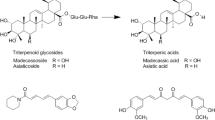Abstract
Lancemaside A, a triterpenoid saponin isolated from the roots of Codonopsis lanceolata, has been reported to ameliorate the reduction of blood testosterone levels induced by immobilization stress in mice. In the present study, we investigated the metabolism and absorption of lancemaside A in mice. After oral administration of lancemaside A at 100 mg/kg body weight, the unmetabolized compound appeared rapidly in plasma (t max = 0.5 h). Lancemaside A has a low bioavailability (1.1%) because of its metabolism by intestinal bacteria and its poor absorption in the gastrointestinal tract. Furthermore, we identified four metabolites from the cecum of mice after oral administration of lancemaside A: codonolaside II, echinocystic acid, echinocystic acid 28-O-β-d-xylopyranosyl-(1 → 4)-α-l-rhamnopyranosyl-(1 → 2)-α-l-arabinopyranosyl ester, and echinocystic acid 28-O-α-l-rhamnopyranosyl-(1 → 2)-α-l-arabinopyranosyl ester. Among these metabolites, codonolaside II and echinocystic acid were detected in plasma, and their t max values were 4 and 8 h, respectively. These findings should be helpful for understanding the mechanism of the biological effect of lancemaside A.





Similar content being viewed by others
References
Sekita S, Kuroyanagi M, Yasuda K, Mizuno I, Ushijima M, Hayama M, Ichikawa M, Sumihiro M (2005) Drug for ameliorating male climacteric disorder. Patent WO200515426
Ushijima M, Mizuno I, Suzuki E, Amayasu R, Ishii S, Nishihama T, Morihara N, Kashimoto N, Mouri Y, Sumioka I, Kuroyanagi M, Sekita S, Hayama M (2007) Improvement of PADAM-like symptoms in middle-aged men by a designer food containing Codonopsis lanceolata. Pharmacometrics 72:23–30
Lee KT, Choi J, Jung WT, Nam JH, Jung HJ, Park HJ (2002) Structure of a new echinocystic acid bisdesmoside isolated from Codonopsis lanceolata roots and the cytotoxic activity of prosapogenins. J Agric Food Chem 50:4190–4193
Lee KW, Jung HJ, Park HJ, Kim DG, Lee JY, Lee KT (2005) β-d-Xylopyranosyl-(1 → 3)-β-d-glucuronopyranosyl echinocystic acid isolated from the roots of Codonopsis lanceolata induces caspase-dependent apoptosis in human acute promyelocytic leukemia HL-60 cells. Biol Pharm Bull 28:854–859
Li JP, Liang ZM, Yuan Z (2007) Triterpenoid saponins and anti-inflammatory activity of Codonopsis lanceolata. Pharmazie 62:463–466
Ushijima M, Komoto N, Sugizono M, Mizuno I, Sumihiro M, Ichikawa M, Hayama M, Kawahara N, Nakane T, Shirota O, Sekita S, Kuroyanagi M (2008) Triterpene glycosides from the roots of Codonopsis lanceolata. Chem Pharm Bull 56:308–314
Yuan Z, Liang ZM (2006) A new triterpenoid saponin from Codonopsis lanceolata. Chin Chem Lett 17:1460–1462
Ushijima M, Mizuno I, Ohta S, Sumihiro M, Mouri Y, Ichikawa M, Hayama M, Sekita S, Kuroyanagi M (2008) Codonopsis lanceolata ameliorate plasma testosterone reduction induced by immobilization stress in middle-aged mice. Pharmacometrics 75:69–75
Han M, Sha X, Wu Y, Fang X (2005) Oral absorption of ginsenoside Rb1 using in vitro and in vivo models. Planta Med 71:398–404
Liang MJ, Zhang WD, Zhang C, Liu RH, Shen YH, Li HL, Wang XL, Wang XW, Zhu JB, Chen CL (2007) Quantitative determination of the anticancer agent tubeimoside I in rat plasma by liquid chromatography coupled with mass spectrometry. J Chromatogr B 845:84–89
Hattori M, Sakamoto T, Kobashi K, Namba T (1983) Metabolism of glycyrrhizin by human intestinal flora. Planta Med 48:38–42
Paek IB, Moon Y, Kim J, Ji HY, Kim SA, Sohn DH, Kim JB, Lee HS (2006) Pharmacokinetics of a ginseng saponin metabolite compound K in rats. Biopharm Drug Dispos 27:39–45
Li B, Abliz Z, Tang M, Fu G, Yu S (2006) Rapid structural characterization of triterpenoid saponins in crude extract from Symplocos chinensis using liquid chromatography combined with electrospray ionization tandem mass spectrometry. J Chromatogr A 1101:53–62
Ha YW, Na Y-C, Seo J-J, Kim S-N, Linhardt RJ, Kim YS (2006) Qualitative and quantitative determination of ten major saponins in Platycodi radix by high performance liquid chromatography with evaporative light scattering detection and mass spectrometry. J Chromatogr A 1135:27–35
Madl T, Sterk H, Mittelbach M (2006) Tandem mass spectrometric analysis of a complex triterpene saponin mixture of Chenopodium quinoa. J Am Soc Mass Spectrom 17:795–806
Shirota O, Nagamatsu K, Sekita S, Komoto N, Kuroyanagi M, Ichikawa M, Ohta S, Ushijima M (2008) Preparative separation of the saponin lancemaside A from Codonopsis lanceolata by centrifugal partition chromatography. Phytochem Anal 19:403–410
Zhang Z, Koike K, Jia Z, Nikaido T, Guo D, Zheng J (1999) Triterpenoidal saponins acylated with two monoterpenic acids from Gleditsia sinensis. Chem Pham Bull 47:388–393
Tabata K, Yamaoka K, Kaibara A, Suzuki S, Terakawa M, Hata T (1999) Moment analysis program available on Microsoft Excel. Xenobio Metab Dispos 14:286–293
Ichikawa M, Ohta S, Komoto N, Ushijima M, Kodera U, Hayama M, Shirota O, Sekita S, Kuroyanagi M (2008) Rapid identification of triterpenoid saponins in the roots of Codonopsis lanceolata by liquid chromatography-mass spectrometry. J Nat Med 62:423–429
Akao T, Kanaoka M, Kobashi K (1998) Appearance of compound K, a major metabolite of ginsenoside Rb1 by intestinal bacteria, in rat plasma after oral administration. Measurement of compound K by enzyme immunoassay. Biol Pharm Bull 21:245–249
Takeda S, Ishihara K, Wakui Y, Amagaya S, Maruno M, Akao T, Kobashi K (1996) Bioavailability study of glycyrrhetic acid after oral administration of glycyrrhizin in rats; relevance to the intestinal bacterial hydrolysis. J Pharm Pharmacol 48:902–905
Li L, Sheng Y, Zhang J, Wang C, Guo D (2004) HPLC determination of four active saponins from Panax notoginseng in rat serum and its application to pharmacokinetic studies. Biomed Chromatogr 18:849–856
Author information
Authors and Affiliations
Corresponding author
Rights and permissions
About this article
Cite this article
Komoto, N., Ichikawa, M., Ohta, S. et al. Murine metabolism and absorption of lancemaside A, an active compound in the roots of Codonopsis lanceolata . J Nat Med 64, 321–329 (2010). https://doi.org/10.1007/s11418-010-0415-8
Received:
Accepted:
Published:
Issue Date:
DOI: https://doi.org/10.1007/s11418-010-0415-8




